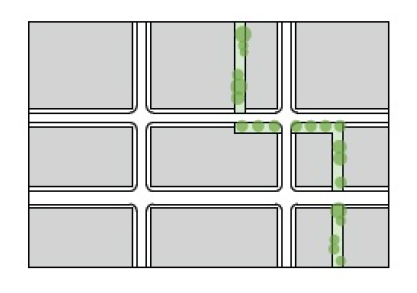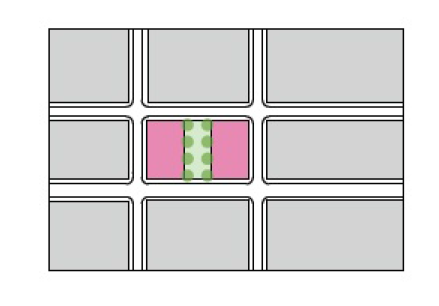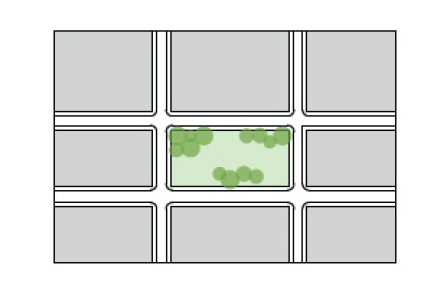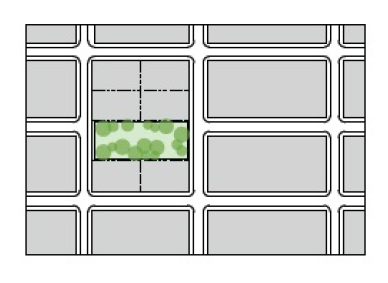The following Open Space Typologies cover land that is intended to be undeveloped within the Olde Reynoldsburg District (ORD Commercial and ORD Neighborhood), consistent with the goals of the Comprehensive Plan.
(a) Greenway and Trail.
(1) Typical lot configuration.

(2) Description. Green ways are primarily linear open spaces that connect other types of open spaces as part of a larger open space system. They typically include a path or trail as a primary feature. The greenway and trail open space is most effect when connecting to another open space type.
(b) Plaza.
(1) Typical lot configuration.

(2) Description. Plazas are spaces availa ble for civic purposes and commercial activities intended to add to the vibrancy of streets and neighborhoods. Building frontages typically define the edges of these spaces. The landscape consists of primarily hardscape. If trees are included, they are formally arranged and of appropriate scale to the space.
(c) Square.
(1) Typical lot configuration.

(2) Description. Squares are medium scale formal open spaces designed to serve as gathering spaces in prominent commercial, civic and mixed-use settings. Squares are typically rectilinear and framed on all sides by streets. They are typically designed with a combination of both hardscape and landscape areas and contain amenities including, but not limited to benches and seating areas, planting areas, walking paths, gazebos or pavilions, fountains, and public art.
(d) Green.
(1) Typical lot configuration.

(2) Description. Greens are medium-scale, informal open spaces designed to provide for active or passive recreation in neighborhood settings, including some landscape areas and is generally for those who live within walking distance.
(e) Passage.
(1) Typical lot configuration.

(2) Description. A passage is an informal or formal gathering space that serves equally as a pedestrian connector between other gathering places or between streetscapes. Passages are near the middle of a block, providing easy walking access through the block. A passage provides additional frontage opportunities for the shops and/or houses along its edges.
(f) Park.
(1) Typical lot configuration.

(2) Description. Parks are larger-scale, typically informal open spaces designed to provide a variety of active and passive recreational opportunities to the general public. Parks may include natural areas. These open spaces may have a variety of forms, with edges defined by streets, neighborhoods, or natural features. Landscaping may be required as deemed appropriate by the Review Authority.
(g) Sport Field.
(1) Typical lot configuration.

(2) Description. A sports field typology is a space or series of open spaces designed for sports activities. Sports fields often accommodate several individual sports games at the same time and may feature a concession area and seating for spectators. Due to the larger amounts of people attracted to this type, sports fields are located to maintain compatibility with adjacent neighborhoods. Landscaping may be required as deemed appropriate by the Review Authority.
(h) Pocket Plaza.
(1) Typical lot configuration.

(2) Description. Pocket plazas are small-scale, primarily hardscaped open spaces designed to provide opportunities for impromptu gathering and resting areas for passersby and for those who live or work in adjacent buildings or nearby destinations. Pocket plazas are typically designed as an extension from the public sidewalk, but clearly delineated as a separate space using features including, but not limited to landscaping and/or seating walls. Pocket plazas are typically located along highly trafficked streets and in commercial areas with frequent pedestrian activity.
(i) Pocket Park.
(1) Typical lot configuration.

(2) Description. Pocket parks are small-scale, primarily landscaped open spaces designed to provide opportunities for neighborhood gathering and typically passive recreation, generally for those who live within walking distance. Pocket parks are typically located in residential neighborhood settings. Landscaping may be required as deemed appropriate by the Review Authority.
(j) Nature.
(1) Typical lot configuration.

(2) Description. Areas that are to remain undeveloped and that generate their physical character through their natural topography, trees, and plants. This open space type is preserved from any development.
(Ord. 33-2020. Passed 3- 23-20; Ord. 103-2021. Passed 7-26-21.)